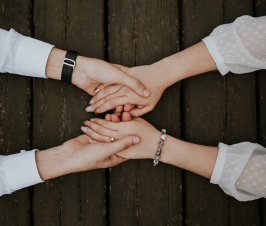A new study, looking at “interpersonal synchronization,” shows that when male partners touch their female partner’s hands during a painful experience, the pain is diminished.1This could be an important role of fathers-to-be in the labor and delivery room (which was the motivation of the study), but also is insightful to how pain may be reduced in many other instances as well.
Interpersonal Synchronization
Interpersonal synchronization is a fairly new area of research, which looks at the phenomenon that when people are in relationship with one another their physiological biorhythms begin to synchronize.2 This synchronization seems to occur when individuals show empathy to one another. In fact, the authors of the current study comment that the more empathetic a partner, the stronger the synchronization.
Synchronization Study
The study looked at 22 long-term heterosexual couples – ages 23-32. They underwent a series of tests which were intended to mimic a delivery-room situation (the female partner was experiencing pain and distress, and the male partner had intentions of soothing her pain and being supportive). Heart rate and breathing, as well as subjective pain scales were used to assess outcomes. Three scenarios were created while the female partner experienced a heat induced pain stimuli on her forearm – the couple sat together, not touching; sat together holding hands; sat in different rooms. Each scenario lasted roughly 2 minutes.
More Synchronization = More Analgesic
To be expected, and supported by previous research, when the couples were merely sitting together they synced physiologically. However, when the female partner was subjected to pain and the male partner could not touch her the synchronization was broken. When he could hold her hand, the synchronization not only returned, but her pain levels were subjectively found to be lower than in other scenarios. The more synchronization the couple showed, the more analgesic (pain reducing) effect was seen with physical touch – which also corresponded with the amount of empathy shown by the male partner.
Nothing New but New Research on Touching Could Provide Tangible Medical Benefit
This is not altogether a new understanding. We have been well acquainted with the occurrence of synchronization for quite some time. People naturally tend to sync their footsteps when walking together, mirror postures when sitting together, mimic emotional states, voice patterns, and research has shown that romantic couples sync cardiorespiratory and brainwave patterns in each other’s presence.3 There is also many unanswered questions regarding this phenomenon, such as occurrence in same sex partners, and age of couples. But this new research may help direct this understanding, and future research, in a focused direction which may help utilize the power of relationship for tangible medical benefit.
Sources
- Goldstein P, Weissman-fogel I, Shamay-tsoory SG. The role of touch in regulating inter-partner physiological coupling during empathy for pain. Sci Rep. 2017;7(1):3252.
- Bavelloni A, Piazzi M, Raffini M, Faenza I, Blalock WL. Prohibitin 2: At a communications crossroads. IUBMB Life. 2015;67(4):239-54.
- Pan Y, Cheng X, Zhang Z, Li X, Hu Y. Cooperation in lovers: An fNIRS-based hyperscanning study. Hum Brain Mapp. 2017;38(2):831-841.
Image Copyright: <a href=’https://www.123rf.com/profile_oneinchpunch’>oneinchpunch / 123RF Stock Photo</a>
 Node Smith, associate editor for NDNR, is a fifth year naturopathic medical student at NUNM, where he has been instrumental in maintaining a firm connection to the philosophy and heritage of naturopathic medicine amongst the next generation of docs. He helped found the first multi-generational experiential retreat, which brings elders, alumni, and students together for a weekend campout where naturopathic medicine and medical philosophy are experienced in nature. Three years ago he helped found the non-profit, Association for Naturopathic ReVitalization (ANR), for which he serves as the board chairman. ANR has a mission to inspire health practitioners to embody the naturopathic principles through experiential education. Node also has a firm belief that the next era of naturopathic medicine will see a resurgence of in-patient facilities which use fasting, earthing, hydrotherapy and homeopathy to bring people back from chronic diseases of modern living; he is involved in numerous conversations and projects to bring about this vision.
Node Smith, associate editor for NDNR, is a fifth year naturopathic medical student at NUNM, where he has been instrumental in maintaining a firm connection to the philosophy and heritage of naturopathic medicine amongst the next generation of docs. He helped found the first multi-generational experiential retreat, which brings elders, alumni, and students together for a weekend campout where naturopathic medicine and medical philosophy are experienced in nature. Three years ago he helped found the non-profit, Association for Naturopathic ReVitalization (ANR), for which he serves as the board chairman. ANR has a mission to inspire health practitioners to embody the naturopathic principles through experiential education. Node also has a firm belief that the next era of naturopathic medicine will see a resurgence of in-patient facilities which use fasting, earthing, hydrotherapy and homeopathy to bring people back from chronic diseases of modern living; he is involved in numerous conversations and projects to bring about this vision.

















